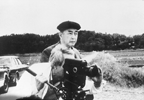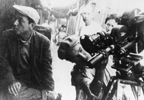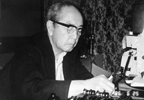Kamei Fumio Retrospective
 Kamei Fumio is an unforgettable presence in the history of Japanese documentary film. Born in 1908, Kamei was raised by Catholic parents and studied fine arts at Tokyo’s Bunka Gakuin, where he developed an interest in the social sciences. He headed towards Moscow to study art under the Soviet system, first landing in Vladivostock, where, bowled over by the films he saw, his interest turned from fine arts to film. At the time, Eisenstein and Vertov’s activities were eye-opening and Kamei became an auditor at the Leningrad Film School, where he studied under Yutkevich, Ermler and Kozintsev.
Kamei Fumio is an unforgettable presence in the history of Japanese documentary film. Born in 1908, Kamei was raised by Catholic parents and studied fine arts at Tokyo’s Bunka Gakuin, where he developed an interest in the social sciences. He headed towards Moscow to study art under the Soviet system, first landing in Vladivostock, where, bowled over by the films he saw, his interest turned from fine arts to film. At the time, Eisenstein and Vertov’s activities were eye-opening and Kamei became an auditor at the Leningrad Film School, where he studied under Yutkevich, Ermler and Kozintsev.
While there he fell in love and fathered a child, but contracted tuberculosis and so returned to Japan to enter a sanitorium his mother had founded. After recovering, he tried to return to his wife and child waiting in the Soviet Union, but the severe social situation kept him from realizing his trip.
Instead he took on a job at Photo Chemical Laboratory (P.C.L.) where he soon distinguished himself. P.C.L. would later become Toho, and Kamei left a number of masterpieces while working for the Toho Culture Films Department, among them Crossing the Waves (1937), Shanghai (1938), Fighting Soldiers (1939) and Kobayashi Issa (1941). Uniquely, Fighting Soldiers lacks the militaristic war spirit popular among films at the time and instead presents a detached description of what Kamei saw on the war front. The film went straight into storage without being shown, and later Kamei was arrested under the Peace Preservation Law and held in custody for a year. As soon as the war ended, Kamei made A Japanese Tragedy (1946) to examine the war responsibility of the emperor, but the film was banned and confiscated by the Occupation forces. A leading figure in the labor strike at the liberal-filled Toho, Kamei planned and co-directed the dramatic film, War and Peace (1947) with Yamamoto Satsuo during the course of the strike. After his next dramatic film, A Woman’s Life (1949), he became a freelancer and made the period film Chobei the Rogue (1949) for Toyoko, later Toei, and directed Become a Mother, Become a Woman (1952) and A Woman Walking Alone on the Earth (1953), films depicting women’s lives for the independent production house Kinuta Productions. He then returned to documentaries with a film dealing with the problem of US military bases, Children of the Base (1953), before starting his own production house, Japan Document Film, and making many talked-about films which questioned society; advocating a ban on atomic and hydrogen bombs in Still It’s Good to Live (1956), showing the struggle against US military bases in Record of Blood: Sunagawa (1956), scientifically proving the terrible nature of atomic energy in The World Is Terrified: The Reality of the “Ash of Death” (1957), and facing the buraku discrimination head on in Men Are All Brothers (1960).
When relations soured between the USSR and China, countries under the Communist party in which Kamei had believed, and the Socialists seceded from the Japanese antinuclear movement, splitting the movement into two, Kamei removed himself from the documentary filmmaking world.
Taking advantage of another interest, he opened an antique shop called “Gallery Toyojin,” and took on many requests to make industrial PR films, directing some himself and passing others to young directors. In his later years he took an interest in ecology. Upon the request of his friend, cameraman Kikuchi Shu, he re-edited footage Kikuchi had shot into All Must Live: People, Insects and Birds (1984), and he turned film footage from different companies into All Living Things Are Friends—Lullabies of Birds, Insects and Fish (1987), which was to become his last film. You could say that Kamei’s whole life was truly dedicated to film.
Ogawa Shinsuke praised Kamei’s The World Is Terrified: The Reality of the “Ash of Death” and Record of Blood: Sunagawa, and director Tsuchimoto Noriaki wrote in memoriam, “Even now, I’d certainly call him my teacher.” The influence of Record of Blood: Sunagawa on Ogawa’s Sanrizuka series (1968–73) is unmistakable, and Tsuchimoto’s Minamata Disease—A Trilogy (1974–75) brings to mind The World Is Terrified: The Reality of the “Ash of Death.” I’m from the generation after the period during which Kamei was active, so I didn’t have the chance to come into contact directly with his films at the time, which is a shame. Watching the films of this filmmaker whose superiority was acknowledged by Ogawa and Tsuchimoto, all I can do is take my hat off to this unwavering and able filmmaker.
The two main bibliographical sources on Kamei are Fighting Film—The Showa History of a Documentary Filmmaker (“Tatakau eiga—Dokyumentarisuto no showashi,” ed. Tanikawa Yoshio, Iwanami Shinsho, 1989) and The Man Who Became a Bird—The Life of Kamei Fumio, Rebel Filmmaker (“Tori ni natta ningen—hankotsu no eiga kantoku Kemai Fumio no shogai,” Tsuzuki Masaaki, Kodansha, 1992). Kamei himself co-wrote History of Soviet Film (“Soveto eigashi,” co-authored with Hijikata Keita, Hakusuisha, 1952) and left meaningful words in many different publications. I highly recommend using this opportunity to read all of these works.
This retrospective is an attempt to look back at the whole of Kamei’s life of film on screen. Unfortunately, several important films such as Song of Ina and Chobei the Rogue had to be omitted because the films are not longer extant. The films in the program are being screened thanks to the generous kindness of Nippon Eiga Shinsha, successor of the Toho Culture Films Department, and of Kamei’s production company, Japan Document Film, and the National Film Center provided us with valuable works no longer owned by the companies. The program has also been made possible through the cooperation of NHK, who graciously lent two of Kamei’s prewar films thought to be made for the NHK. We are grateful to have his PR films thanks to DENTSU TEC, previously Dentsu Eigasha, and each of the sponsors. I would also like to thank all of the people who worked on the catalog of the Kamei Fumio Retrospective, especially the head of Japan Document Film, Abe Yutaka, and Japanese film historian Makino Mamoru. Once again, I would like to offer my deepest thanks to all who made this program possible.
—Yasui Yoshio, Coordinator of the Kamei Fumio Retrospective


|
|
